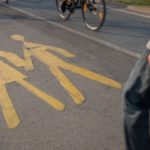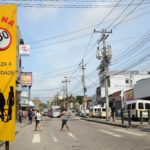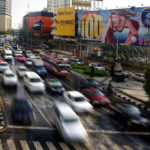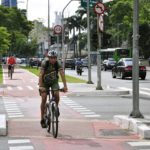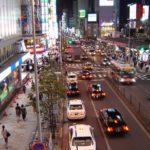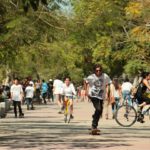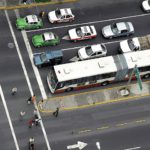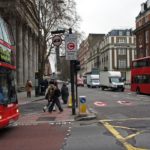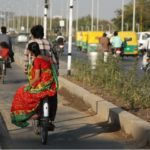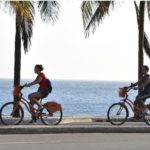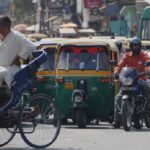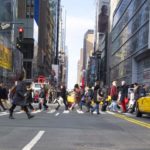Recent Posts by Ben
This series, supported by the Volvo Research and Educational Foundations, discusses walking and cycling in cities with a special focus on low- and middle-income countries. Walking and cycling are getting more and more attention in wealthy cities, as ideas about ...

This week is UN Global Road Safety Week, focused on the theme “Slow Down, Save Lives.” WRI works to make cities around the world safer and more sustainable by implementing street design and regulations that reduce vehicle speeds while supporting walking and ...

This week is UN Global Road Safety Week, focused on the theme “Slow Down, Save Lives.” WRI works to make cities around the world safer and more sustainable by implementing street design and regulations that reduce vehicle speeds while supporting walking ...

In January, at Washington D.C.’s Transforming Transportation, representatives from ten global cities gathered to share how they are fighting the unacceptable level of traffic deaths in their cities. While they may differ in many ways, the cities share a common ...

In Beijing, Chennai and Fortaleza, the rate of fatalities from road crashes is more than 15 deaths per 100,000 residents. What do these cities have in common? They have traffic lanes wider than 3.6 meters (11.8 feet). A long-standing belief ...

The coming of autonomous vehicle technology shows great promise for eliminating traffic deaths and serious road injuries. They could also make life a lot easier, but only if they are done right. Reducing traffic fatalities will depend on how cities ...

The famed American landscape architect and Central Park designer Fredrick Law Olmsted said that parks are the “lungs of the city.” However, many cities around the world—from growing Addis Ababa to sprawling Mumbai and dense Sao Paulo—currently lack adequate public ...

Traffic accidents kill more than 1.2 million people every year, nearly the same amount that die from HIV/AIDS. But there’s an undervalued approach to making the world’s roads safer—good urban design. While most traffic safety initiatives tend to focus on ...

When you consider the global statistics, it’s no surprise that this year’s U.N. Global Road Safety Week focuses on children’s safety. According to a 2008 World Health Organization (WHO) report, 21 percent of all road traffic-related fatalities worldwide were among ...

In 2003, London adopted a program of congestion pricing that now places a roughly $17 (£11.50) daily fee on motor vehicles entering central London. The effort was expected to reduce car traffic, air pollution, and emissions in the area, and ...

Walking and cycling may be the two most basic modes of transport, but they may also be the most promising for a sustainable future. In a car-filled world, it’s the people who use their own two feet or two wheels that ...

Two weeks ago, the World Bicycle Forum in Medellín, Colombia brought together more than 4,000 attendees from across the globe to discuss the challenges and opportunities of urban cycling. Many have praised the event for its ability to bring a ...

Cities worldwide face the pressing challenge of growing motorcycle fleets and remarkable increases in related traffic fatalities. With streets ill-prepared and motor-bikes whizzing in every direction, the scene might best be described as urban transport anarchy. The problem is especially ...

With the next few decades expected to witness to Asia’s swift rise in economic and political influence, the eyes of the world have focused on Asian cities as the engines of this growth. Last month’s Asian Development Bank Transport Forum ...

TheCityFix recently interviewed Paul Steely White – Executive Director of Transportation Alternatives – regarding the organization’s role in successfully advocating for New York City to adopt a “Vision Zero” approach to road safety. First adopted in Sweden, Vision Zero is ...

 Phil
Great article! A lot of what I have read here, has already been implemented in cities in the Netherlands, with Denmark the two bicycle countries par...
Phil
Great article! A lot of what I have read here, has already been implemented in cities in the Netherlands, with Denmark the two bicycle countries par...
 Bobby Salvin
I understand why some people wish mobility and GDP weren't connected, but it's wishful thinking. During the pandemic, for instance, when the economy...
Bobby Salvin
I understand why some people wish mobility and GDP weren't connected, but it's wishful thinking. During the pandemic, for instance, when the economy...
 Peace
Let me understand your Position -
We need to make our streets and public spaces dangerous and inhospitable so the disabled and infirm are forced to...
Peace
Let me understand your Position -
We need to make our streets and public spaces dangerous and inhospitable so the disabled and infirm are forced to...




